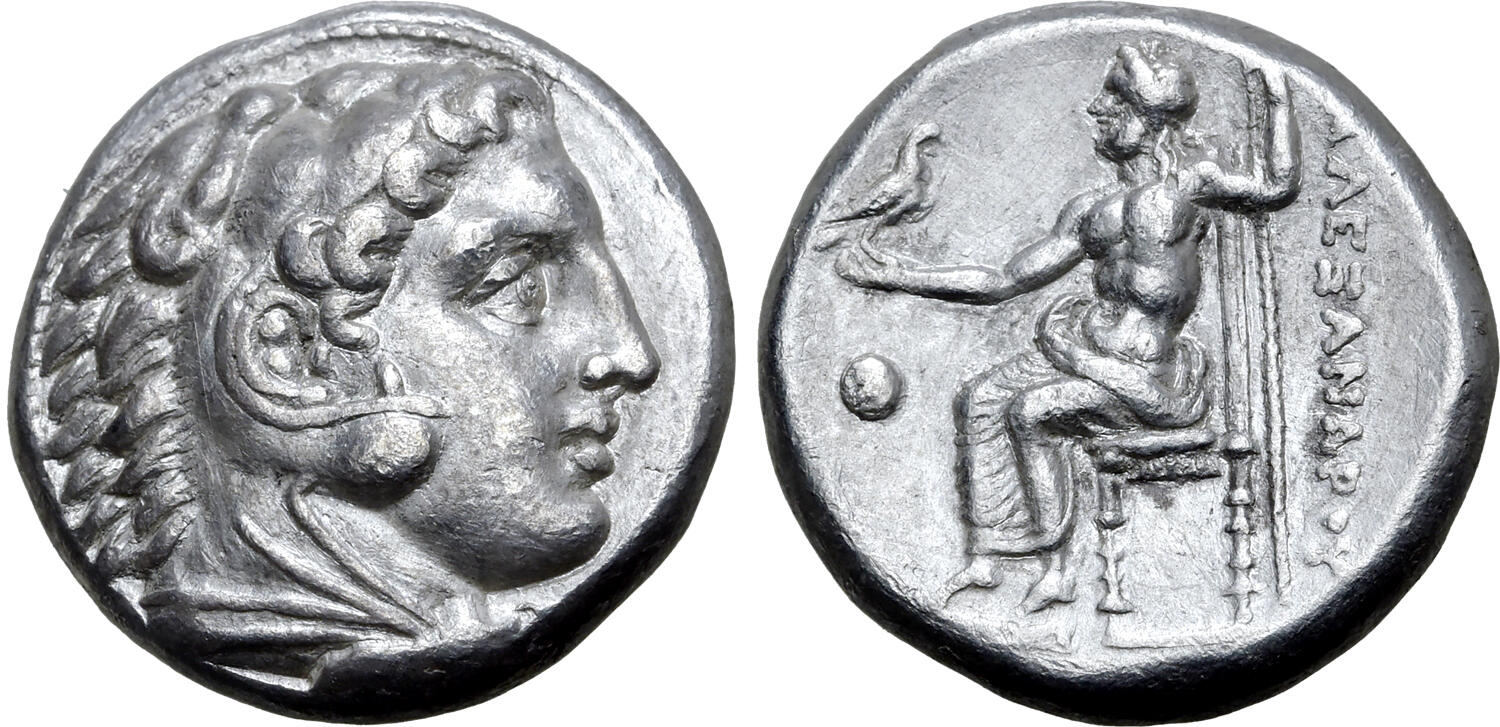315 BCE - 306 BCE | AΛEΞANΔPOY
Overstriking coin
Alexander the Great on Alexander the Great - Leu, Web 18, 18 Dec. 2021, 573.jpg
[1]
Overstruck variety
Alexander the great tetradrachm.jpg
[2]
|
|
Sale(s)Sale(s) ᵖ:
|
Leu, Web 18, 18 Dec. 2021, lot 573.
|
| Private collection(s)Private collection(s) ᵖ:
|
From a European collection, formed before 2005.
|
|
Description
| ObverseInscription or printing placed on the obverse.:
|
Head of Herakles to right, wearing lion skin headdress
|
ReverseInscription or printing placed on the reverse.:
|
AΛEΞANΔPOY (Greek) Zeus seated left on low throne, holding long scepter in his left hand and eagle standing right with closed wings in his right, to left, monogram and rudder, below throne, monogram of ΠE
|
Mint and issuing power
Chronology
| FromIdentifies the initial date in a range assigned in a numismatic context. 315 BCE toIdentifies the final date in a range assigned in a numismatic context.. 306 BCE
|
Hellenistic 323-30 BC  periodTime period of the numismatic object. periodTime period of the numismatic object.
|
Physical description
MetalThe physical material (usually metal) from which an object is made.: Silver 
|
WeightWeight of the numismatic object (in grams). in grams: 17.1117.11 g <br />17,110 mg <br />
|
DenominationTerm indicating the value of a numismatic object. Examples: tetradrachm, chalkous, denarius.: tetradrachm 
|
AxisDescribes the directional relationship between the obverse and reverse of a numismatic object.: 1212 mm <br />1.2 cm <br />
|
| DiameterDescribes diameter of an object (in mm).: 2727 mm <br />2.7 cm <br />
|
StandardStandard.: Attic
|
References
Description
| ObverseInscription or printing placed on the obverse.:
|
Head of Herakles right, wearing lion skin
|
ReverseInscription or printing placed on the reverse.:
|
BAΣIΛEΩΣ AΛEΞANΔPOY (Greek) Zeus seated left on throne, holding eagle and scepter
|
Mint and issuing power
Chronology
| FromIdentifies the initial date in a range assigned in a numismatic context. 332 BCE toIdentifies the final date in a range assigned in a numismatic context.. 306 BCE
|
Hellenistic 323-30 BC  periodTime period of the numismatic object. periodTime period of the numismatic object.
|
Physical description
| DenominationTerm indicating the value of a numismatic object. Examples: tetradrachm, chalkous, denarius. ᵖ:
|
tetradrachm 
|
StandardStandard. ᵖ:
|
Attic
|
References
References
- ^ Price, Martin Jessop (1991), The Coinage in the Name of Alexander the Great and Philip Arrhidaeus: a British Museum Catalogue, 2 vol., Zürich-London, 637 p., 637 p., clix pl.

